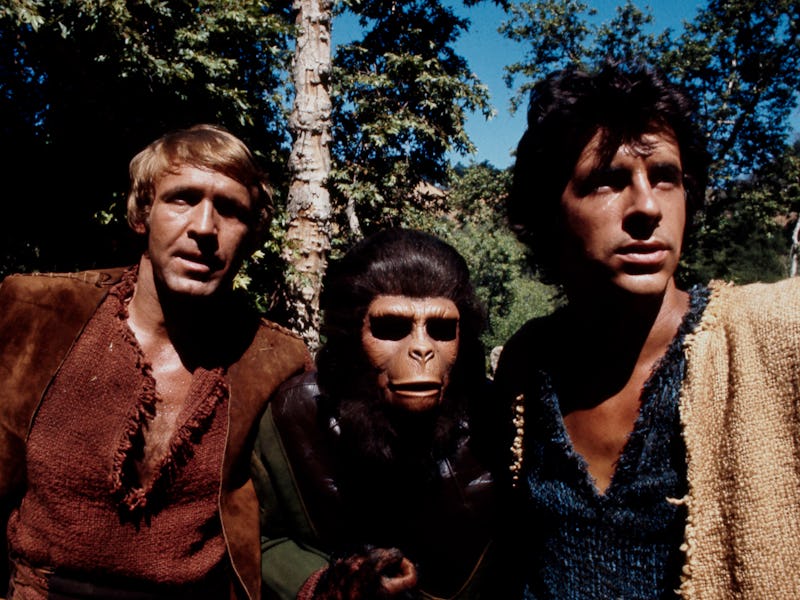Believe It Or Not, There Was A Planet of the Apes TV Show
Before the franchise was rebooted in the 21st century, its last gasp was a forgotten TV relic.

Planet of the Apes was the first successful modern science fiction franchise. Starting in 1968 with the classic original film, starring Charlton Heston as an astronaut who finds himself back on Earth in a distant, post-apocalyptic future where apes have become the dominant species, 20th Century Fox produced a total of five Apes films, creating an extraordinary saga that used time travel to loop back on itself and become a self-perpetuating, dystopian future history.
By the time the fourth and final sequel, Battle for the Planet of the Apes, arrived in May 1973, shrinking box office signaled the end of the theatrical film series. But blockbuster ratings for the network TV premieres of the first three movies on CBS-TV led both Fox and the network to entertain the idea of creating an Apes television series.
According to the book Planet of the Apes Revisited (by Joe Russo, Larry Landsman, and Edward Gross), Fox and CBS hired The Twilight Zone creator Rod Serling — who had co-written the first Apes film — to pen a series bible for the show. Although the final product that premiered on September 13, 1974 was vastly different in many ways, it retained Serling’s basic framework: two astronauts, eventually named Alan Virdon (Ron Harper) and Pete Burke (James Naughton), take off from Earth in 1980 but crash-land back on their home planet more than 1,000 years in the future.
Human civilization has destroyed itself in a nuclear holocaust, allowing intelligent, speaking apes to develop their own society while humans — who can still talk and think at this point — either live under the apes’ rule or in remote agrarian conclaves. Virdon and Burke, accompanied by a friendly chimp named Galen (Roddy McDowall), are pursued by the orangutan official Zaius (Booth Colman) and the gorilla military leader Urko (Mark Lenard, best known for playing Spock’s father Sarek in multiple Star Trek TV shows and films), who want the humans dead and their existence kept a secret.
The return of Roddy McDowall, a staple of the Planet of the Apes franchise, lent the TV series legitimacy.
The show had a few things going for it: it was expensive (for TV at the time), most likely due to the extensive makeup required for the ape characters; the makeup itself maintained the generally high standards set by the films; and the show was graced by the presence of McDowall, who had appeared in four of the five films and became in many ways the face of the franchise.
It’s a credit to this often-underrated actor that even under essentially the same ape makeup, he manages to make Galen distinct from Cornelius and Caesar, the earlier characters he had played. Galen is compassionate, occasionally self-pitying, and funny; he longs for his previous comfortable life as a chimp from a well-connected family, but his world is turned upside-down upon meeting Virdon and Burke and learning of humanity’s previous supremacy on Earth.
The other characters were less well-served. The upstanding Virdon is obsessed with finding a mythical hidden repository of human knowledge in the hope that it can provide a way to return to his family, while the cockier Burke is resigned to their fate and just wants to survive in the here and now. Zaius and Urko are almost exact counterparts to the film series’ Dr. Zaius and General Ursus (right down to their names), with the former dedicated to preserving the ape society’s status quo and the latter interested only in exterminating humans and amassing power.
How the show fits into the Apes continuity is not precisely clear. It most resembles Battle in some ways, as humans have not descended to the savagery of the first two films and exist mainly as meek subordinates to the apes. But the show also postulates an advanced human society existing as late as the 26th century, while the films establish the downfall of humanity as starting in the early 1990s (we also see dogs in this show, while in the movies a plague wipes out all dogs and cats).
None of these questions ever had a chance to get answered, however, because Planet of the Apes was canceled after just 14 episodes were produced; its final segment aired on December 20, 1974. Programmed on Friday nights against NBC’s smash sitcom duo of Sanford and Son and Chico and the Man, the Apes series never garnered enough viewers to keep the pricey production going for very long.
One of the issues with the series was its redundant adventure-of-the-week structure.
But Planet of the Apes had another very distinct problem: it played like a combination of The Fugitive and a standard Western. The show settled quickly into a tedious, repetitive formula in which Galen, Burke, and Virdon would come upon a community of humans (and sometimes apes) and help them in some fashion, with one of the trio inevitably captured by Urko and Zaius before escaping by the end. What was missing was the surrealism, social commentary, and utter weirdness that make the original Apes films so unlike anything else released at the time, and keeps them beloved and watchable to this day.
“My interest was making the show for adults and hopefully the kids would enjoy it too,” producer Herbert Hirschman told Russo, Landsman, and Gross. “But the focus changed.” The grind of network series television in the 1970s rarely allowed for sophistication and imagination, and Planet of the Apes, the TV series, is now a curious footnote to a franchise that continues to thrive and fascinate audiences today — but only on the big screen.